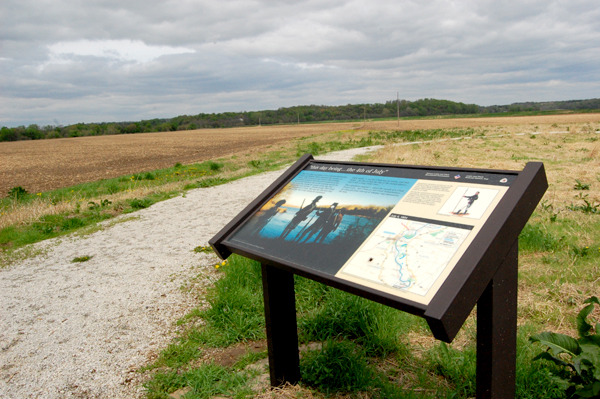Address: 200 S. 10th, Atchison, KS
Phone: 913.367.2427
Website: www.atchisonhistory.org/independencecreek.html

The Kanza Indians and Lewis and Clark shared a common area at different times making Independence Creek one of the 8 Wonders of Kansas History.
 The Kanza's Independence Creek settlement was noted as the
main village of the tribe as far back as 1673. By the time French explorer
Etienne Veniard de Bourgmont arrived in 1724, it was considered an old village and
the capital of the Kanza nation.
The Kanza's Independence Creek settlement was noted as the
main village of the tribe as far back as 1673. By the time French explorer
Etienne Veniard de Bourgmont arrived in 1724, it was considered an old village and
the capital of the Kanza nation.
LEWIS & CLARK
When Lewis and Clark came down the Missouri River on their historic government-sponsored exploration of the
Ironically, both times the Lewis and Clark expedition visited the area (July 1804 and Sept. 1806), the Kanza would have been at their buffalo hunting grounds to the west. When the expedition came through here in 1804, Clark noted the size of the village and his questions about the village being empty in his journal.
 INDEPENDENCE CREEK
INDEPENDENCE CREEK
Today, a recreated Kanza dwelling and a Lewis & Clark historic site are side by side near the point where Independence Creek flows into the Missouri River.
The historic Kanza dwelling was eclectic, using the most available
building materials. Their early migration from the areas near the
The Kanza lived in permanent villages, cultivated crops like beans, pumpkins, potatoes, melons and corn. Though fish, fowl and dog meat were important sources of food for the Kanza, they participated in the nomadic practices of other plains tribes. The entire tribe made two hunting trips to the hunting grounds each year, using buffalo and deer skins to construct tipis for shelter during the long expeditions to the high plains.
 Hikers, cyclists and
history buffs should all be interested in making the 10-mile round-trip trek to the Independence Creek
area once
inhabited by the people who gave their name to our state. Along the way, markers tell about Lewis and Clark's expedition and the
early history of the area.
Hikers, cyclists and
history buffs should all be interested in making the 10-mile round-trip trek to the Independence Creek
area once
inhabited by the people who gave their name to our state. Along the way, markers tell about Lewis and Clark's expedition and the
early history of the area. LEARN MORE AT THE ATCHISON COUNTY HISTORICAL MUSEUM
The Kanza lodge and Lewis and
Photos courtesy Atchison Area Chamber of Commerce